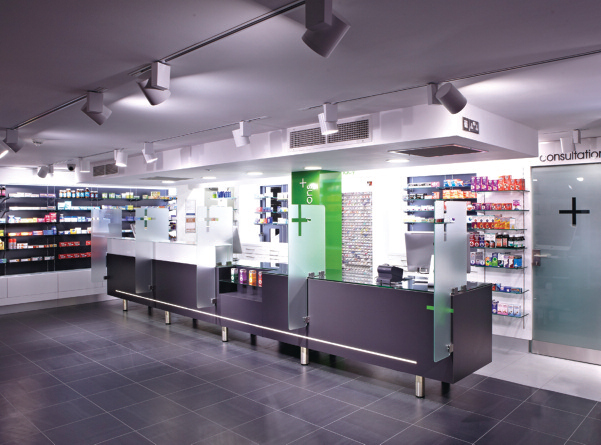Back to the future €“ what next for pharmacy?
In Analysis
Follow this topic
Bookmark
Record learning outcomes
Last month we looked back over the 21 years since Pharmacy Magazine was launched. Now Mike Holden peers into his crystal ball and tries to predict what the future holds for pharmacy.

In order to understand where pharmacy could be in 21 years' time, we first need to understand what the health needs of an increasing and ageing population might be and also predict €“ as far as one can €“ the likely economic situation.
Spending on health has doubled since Pharmacy Magazine was launched 21 years ago and grown at an average of 4 per cent a year since the inception of the NHS. Given the current economic climate and future trends, this level of growth is unsustainable. If the NHS share of the public purse were to be maintained, we would be seeing annual increases of only 1.2 per cent, which would be insufficient to cope with demographic change and the resultant demands on our health and social care systems.
Do we want our future to be led by the profession or by the Government?
Visions galore
 There have been many visions for the pharmacy profession but the most recent from the English Government was way back in 2008 €“ the pharmacy white paper, Building on Strengths €“ Delivering the Future.1 This was fairly ambitious for its time and broadly welcomed, but few of the aspirations were either delivered by the Department of Health or fully embraced by the profession.
There have been many visions for the pharmacy profession but the most recent from the English Government was way back in 2008 €“ the pharmacy white paper, Building on Strengths €“ Delivering the Future.1 This was fairly ambitious for its time and broadly welcomed, but few of the aspirations were either delivered by the Department of Health or fully embraced by the profession.
Since then, the only real hints regarding future developments from the NHS and Department of Health were in the letter sent out just before Christmas2, which announced a £170m (6 per cent) cut in funding for community pharmacy in England. Other changes indicated included further digitisation of the medicines supply service, a strong desire to centralise dispensing (so-called 'hub and spoke' but in reality remote assembly), the creation of an integration fund and the threat of a potential reduction in the number of pharmacy contracts. Some of this intent was reinforced by the document released in November by the Treasury, ironically called A Better Deal.3
Wales and Northern Ireland have also launched strategies but, in reality, little has changed in the past 10 years. The primary source of funding still comes from dispensing activity and procurement. Scotland is the exception.
Since 2006, Scotland has had a different and more progressive pharmacy contract and now has the Prescription for Excellence strategy4 as well as a new chief pharmaceutical officer who is passionate about the profession.
Pharmacy bodies have drawn up visions too, with the Now or Never5 report from the RPS and the Nuffield Trust's subsequent review, Now More Than Ever6. There was also the joint Pharmacy Voice and PSNC Manifesto for Community Pharmacy7 €“ but has anything really changed?
A key question we need to ask is: do we want our future to be led by the profession or by the Government? Currently, about 85-95 per cent of pharmacy funding comes from the NHS, but the sector cannot continue to rely on this high volume, low margin activity. One thing for certain is that change will be the only constant. Those who stand still will go backwards or disappear. Things have to change €“ but that doesn't mean we have to change everything. We must stop doing some things and start doing others.
So what might the new community pharmacy offer be? I have two suggestions. One I will call Nirvana and the other I have termed Amazonia.
Nirvana
Nirvana is a community care hub joined up with other care providers from the NHS, public health and social care, including the private and third sector. Figure 1 illustrates the potential domains of practice that reflect both the needs of people in our communities, but also funding streams to ensure ongoing relevance and viability. Some of these activities will, increasingly, be delivered away from pharmacies and where the people are.
Pharmaceutical care (NHS and insurer funded)
Pharmaceutical care was recently redefined by the Pharmaceutical Care Network of Europe as: €The pharmacist's contribution to the care of individuals in order to optimise medicines use and improve health outcomes€.8 For me, this sums up perfectly the future role of community pharmacy as it relates to medicines. It goes beyond safe and efficient supply.
It can and should involve the whole pharmacy team, particularly technicians, and gives the sector the opportunity to take ownership of the medicines agenda. It will need funding, but one way could be to take establishment and practice allowances, procurement margin, dispensing fees and MUR and NMS fees (or equivalents) and fund those who deliver a full patientfacing pharmaceutical care service, not a supply management system.
Medicines provision in 21 years' time may look very different with the advent of personalised medications and pharmacogenetics. Imagine medicines no longer being delivered by your wholesaler in packets but in the equivalent of ink cartridges that you put into a robot linked to your patient management system. The robot would then produce precise strengths, formulations and quantities of the drugs a patient requires that you would then dispense, perhaps utilising a 3D printer.
Wellbeing (public health and individual funded)
This is a health-promoting ethos with interventions that increase health awareness, and prevent and protect from ill-health.
Supported self care (funded by individuals and NHS)
This domain concerns advice about and the treatment of common illnesses, plus support to help individuals to take ownership of their health and wellbeing.
Independent living (social care, insurer and individual funded)
This domain is about supporting an ageing population to live in their own homes and to stay out of hospital.
Visually, pharmacy probably will not change much but expect a community pharmacy in 21 years to be carrying a limited nonhealthcare inventory, have multiple consultation rooms and areas, and more visible use of technology. There are also likely to be more pharmacies hosting private and NHS dentists, optometrists, nurses and GPs. So that's Nirvana. Now let us turn our attention to Amazonia.
Amazonia
 Recent talk of reductions in the number of pharmacy contracts in England, increased digitisation and centralised dispensing falls into the lap of those wanting to further commercialise and 'transactionalise' medicines supply.
Recent talk of reductions in the number of pharmacy contracts in England, increased digitisation and centralised dispensing falls into the lap of those wanting to further commercialise and 'transactionalise' medicines supply.
They want to bypass the community pharmacy network and have a hub and spoke operation where the spoke is a patient's home, place of work or a Doddle-like collection centre. Not only would this have a massive impact on the significant investment already made in the network, it would also have an impact on communities and access to care.
However, we cannot put our heads in the sand and assume that the expectations of people and funders will not change €“ because they are already changing. Look at the impact the digital, online shopping and 'click and collect' revolution has had on companies such as Kodak, HMV and Nokia.
The challenge will be to embrace technological advances while ensuring that pharmacy's offer adapts to remain compelling and relevant to future needs. So what needs to happen?
With the exception of Scotland, we currently have a medicines supply function, with MURs and the NMS as separate services. (Only Scotland has had the vision to move towards contracting pharmaceutical care with its Chronic Medication Service.9) This leaves the system and, most importantly, patients with varied access to pharmaceutical care and doesn't create the necessary momentum to shift pharmacy from a supply role to interactional (pharmaceutical) care. It also leaves community pharmacy operating in a silo from the rest of the profession and other care providers. This needs fixing now, never mind in 21 years' time.
We have to accept that there will be no more money in the system €“ so how do we make the case for a larger slice? One thing pharmacy must do is ensure that organisational development and the management of change is embedded in its operating model and culture in order to adapt to a rapidly evolving landscape €“ and the sector must be quick to adopt new innovations. Key elements include:
Workforce development
New knowledge and skills will be required for the future. This includes enhanced clinical knowledge, independent prescribing, communication and behavioural change skills, plus leadership and management skills that fully engage, support and lead individuals, pharmacy teams and the profession.
Lean working and quality improvement
We need new ways of operating that drive efficiencies to release capacity and improve safety.
Technology and automation
Technology and automation does not mean that so-called centralised dispensing and robotics are always the solution €“ that is a business decision €“ but if they cost-effectively release capacity to deliver more healthrelated and funded services, then they should be considered seriously. Pharmacists must also have read/write access to a summary care record, PMR systems must become integrated patient management systems, and two-way e-communication with patients should be enabled.
Premises
Premises must create a quality experience and a health-promoting and patient-friendly environment with multiple consultation areas. And they must be located in the community.
Engagement and integration
Engagement and integration is all about creating virtual pharmacy teams across all areas of practice and the whole care system.
Making it happen
To have a chance of making this happen, pharmacy must move to a culture and practice that works as one with other care providers and is centred around people's needs.
The goal should be to become the care hub for a community. One where the care of people and the experience pharmacy teams give them is central to all pharmacy does. One where the sector leads the medicines agenda; where doctors diagnose, pharmacists prescribe and ensure good outcomes from medicines, and technicians lead on dispensing and technical processes. One where pharmacy is fully integrated with other providers and where every contact counts.
Key to a successful and viable future will be the quality of the experience pharmacy gives to patients, and the value and quality of outcomes delivered to those who fund the service. Unless pharmacy itself embraces and leads this change, the profession is at risk of becoming irrelevant to modern care systems.
So what do we want: Nirvana or Amazonia? The outcome is likely to be a mix of the two. The future is potentially bright €“ but it is up to us to create it.
References and credits
- Department of Health: Pharmacy in England - Building on strengths €“ delivering the future
- Department of Health: Letter to Sue Sharpe - Community pharmacy in 2016/17 and beyond
- A better deal: boosting competition to bring down bills for families and firms
- A Vision and Action Plan for the right pharmaceutical care through integrated partnerships and innovation
- RPS: Now or Never - Shaping Pharmacy for the Future
- Nuffield Trust: Now or Never - Why pharmacy needs to act
- Pharmacy Manifesto: How can you take action
- PCNE: Position Paper on the definition of Pharmaceutical Care 2013
- NHS Scotland: Chronic Medication Service (CMS)
Lead image courtesy of Abbey Pharmacy
Mike Holden is principal associate at Pharmacy Complete.
